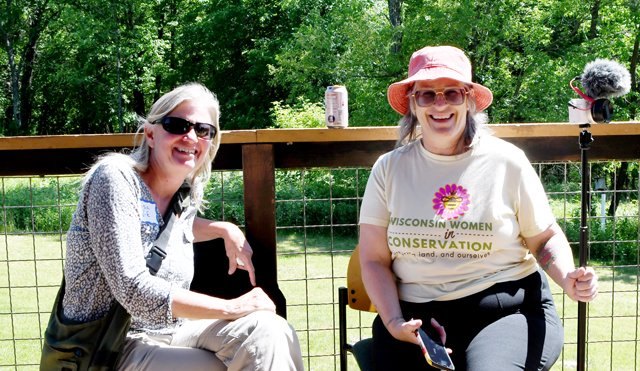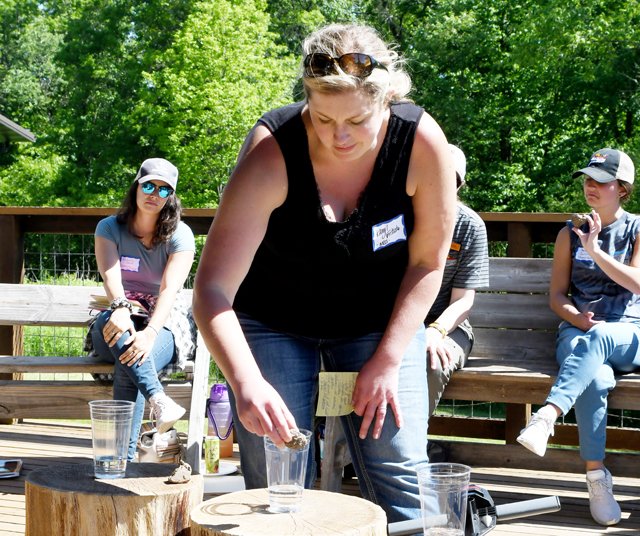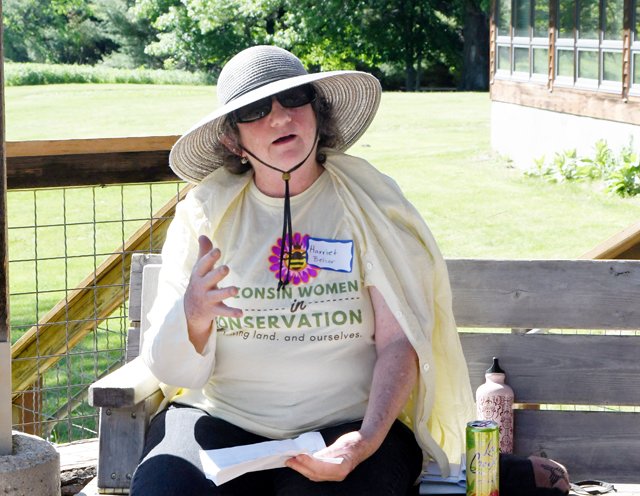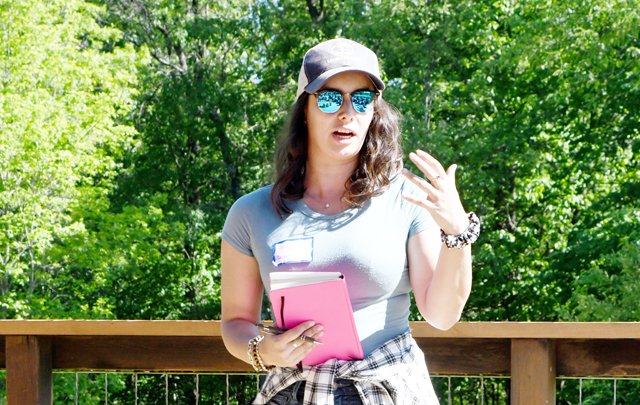DRIFTLESS - It was a beautiful day on Friday, June 3, for a group of women farmers, landowners and others interested in conservation to gather on the deck of the Kickapoo Valley Reserve’s Visitor Center. About 30 women from Southwest Wisconsin attended the educational event sponsored by Wisconsin Women in Conservation (WiWiC).
WiWiC is a statewide collaborative effort led by the Michael Fields Agricultural Institute in partnership with Renewing the Countryside, the Midwest Organic and Sustainable Education Service (MOSES), and Wisconsin Farmers Union. A three-year multi-faceted project funded by the USDA’s Natural Resources Conservation Service (NRCS), WiWiC brings together Wisconsin women landowners to connect and learn about conservation practices, resources, and funding opportunities.

WiWiC staff present at the gathering included Kriss Marion, media and communications, Rebecca Cristoffel, project evaluator, Sarah George, West Central Regional Coordinator, and Elena Gutierrez Byrne, the Southwest Regional Coordinator.
In addition to conservation planning, WiWiC also offers regional field days, a virtual summer series, educator meet-ups, and a spring and fall regional workshop.
The event offered women landowners information about building soil health, and various programs and providers that could help them pursue conservation goals on their land.
Presentations were made by USDA-NRCS District Conservationist for Crawford County, Karyl Fritsche, as well as by Britta Peterson of Pheasants Forever, Harriet Behar, and Barbara Ducre of the Savanna Institute.
Participants travelled to the event from LaCrosse, Boscobel, Spring Green, Polk County, Vernon County, northern Illinois, Gays Mills, Pepin County, Richland County, Iowa County, Fennimore, and Lafayette County.
USDA-NRCS
Fritsche told the women that she has worked with USDA-NRCS for over 30 years in several different states. She explained that NRCS has a service center in every county in the U.S., and that the agency’s mission is to assist with conservation on private and working lands.
“I want to emphasize to you the value of obtaining a conservation plan for your land, and we can help connect you with specialists in a broad range of categories,” Fritsche said. “There has been a significant increase in funding in the last few Farm Bills, but the best thing my agency can offer is experience and access to a bunch of really smart people in our conservation partners.”
Fritsche said that the conservation plan experience for a landowner would begin with a site visit, where the landowner could share their conservation goals, and NRCS staff could assess the land for conservation issues and opportunities. From there, assistance would be provided to pursue any needed cost share funding, and in identifying partners to help plan and implement projects.
“We know that sometimes pursuing conservation goals on land can seem a daunting prospect, and we encourage landowners to chunk the work out in manageable increments,” Fritsche said. “You don’t have to do it all at once, and NRCS is comfortable with a stepped approach.”
Fritsche said that though the Conservation Reserve Program (CRP) is administered by the Farm Services Agency (FSA), NRCS is the technical support agency for the program. In addition to CRP, other sources of conservation funding available through NRCS include the Environmental Quality Incentives Program (EQIP), the Conservation Stewardship Program (CSP), and the Beginning Farmer Program, which Fritsche said is an ‘All-USDA’ program.
Fritsche went on to discuss the enhanced focus on soil health at USDA-NRCS.
“For the last 20 years, our agency approached the topic of soil health like a chemistry experiment – how much do you need to put in to get the right number of bushels out,” Fritsche explained. “In recent years, the focus has shifted beyond yield, to see soil health as a means of reducing runoff that contributes to flooding, protecting the ground and surface waters, sequestering carbon to mitigate climate change, and more.”


Fritsche conducted a ‘slake test’ for the meeting participants, demonstrating the characteristics of healthy soil. The test involved three glasses of water, and three chunks of dry soil from three different land management systems ranging from pasture, to tilled row crops, to no-till row crops. The soil chunks were placed in the water, and allowed to sit in it for a period of time. In the end, the healthier soil held together better, and absorbed the water throughout.
“Healthy soil will have lots of good structure that holds it together and helps resist erosion,” Fritsche explained. “It will also have lots of pore spaces in it, which allow water to infiltrate.”

Fritsche also demonstrated use of a ‘penetrometer’ to the group. The device is used to assess the extent of compaction in the soil, which Fritsche says has a direct correlation to the soil’s capacity to infiltrate water. She said that the devices are commonly available through USDA-NRCS offices, and are easy to use.


Pheasants Forever
Britta Peterson, who travelled to the event from her home in Polk County, described the work of Pheasants Forever, and what the organization has to offer to women landowners in pursuing conservation goals on their land.
“Pheasants Forever was started by hunters interested in preserving habitat for pheasant,” Peterson explained. “Since then, the work of the organization has broadened to include wildlife habitat in general.”
Peterson said that the organization has lobbyists that work in Washington D.C. to encourage investment in grassland programs through legislation. And then, the organization has chapter organizations that work locally to raise funds and implement habitat projects.
“The good thing about Pheasants Forever is that a lot of the money raised by chapters is spent locally,” Peterson said.
Other sources of funding that can be accessed through working with Pheasants Forever on wildlife habitat projects include USDA-NRCS and Wisconsin DNR. Peterson’s area of coverage includes nine counties in the southwest part of Wisconsin.
“I can assist you with a site visit and land assessment, and in developing goals for your land,” Peterson said. “The types of projects we can help with include habitat development, controlling invasive species, and installation of prairies and savannas.”
Peterson said that she also partners with U.S. Fish & Wildlife Services, the Prairie Enthusiasts, and the Nature Conservancy.

Harriet Behar
Harriet Behar introduced herself as a woman landowner who runs several farming businesses, including organic vegetable production, a solar greenhouse and bedding plants business, as well as a weaving business. She has been involved with organic agriculture for many years, serving as Organic Valley’s first marketing director, and recently completed a term on the National Organic Standards Board. In addition, Behar worked for many years as an organic inspector, and for the Midwest Organic and Sustainable Education Services (MOSES).
“I work under WiWiC, and assist woman landowners in writing conservation plans for their land,” Behar said. “The plans I write aren’t full plans like you would get from someone like Karyl Fritsche, but rather are more of a big picture plan, helping to identify conservation concerns and opportunities on your land.”
Behar said her work can range from recreational lands to working lands, and she can assist landowners in identifying what funding to apply for that will help them pursue their conservation goals.
“Sometimes, when you can get a fresh set of eyes looking at your land, it can be very helpful,” Behar said. “I can help you break down projects into do-able chunks, and group them where there may be synergies.”
Behar explained that because she works under WiWiC, the cost to the landowner for a conservation plan written by her is zero. She said that she also has experience in navigating the application process for funding, including with where there may be flexibility with some of the guidelines to help adapt the work to best fit the land and the landowner’s goals.

Savanna Institute
Barbara Ducre, originally from France, now lives in Madison and works as a Community Agroforester with the Savanna Institute.
The Institute is headquartered in Madison, with satellite operations in northern Illinois and the Spring Green area. The satellite operations consist of a series of demonstration farms where integration of trees with agricultural production is modeled.
In addition, the Spring Green campus includes a nursery and plant variety development business, where varieties of trees and shrubs are developed that can best be integrated into agroforestry operations as crops in their own right. Examples of varieties under development include Chestnut trees, Hazelnut trees, Elderberries and more.
Most recently, a partner business, Canopy, has been launched, to supply plants and technical installation services to farmers looking to incorporate agrofestry into their production systems.
“Diversity in agricultural production systems is a big focus of the Savanna Institute,” Ducre explained. “We can help with different agroforestry practices such as silvopasture, alleycropping, riparian streambank buffers, windbreaks and forest farming.”
Ducre said the Savanna Institute can provide technical support to landowners who are ready to plant trees. She said they are a USDA-NRCS authorized service provider that can write agroforestry and silvopasture plans.
Ducre said that the Savanna Institute website offers lots of educational information, including a free online agroforestry course with multiple modules.




